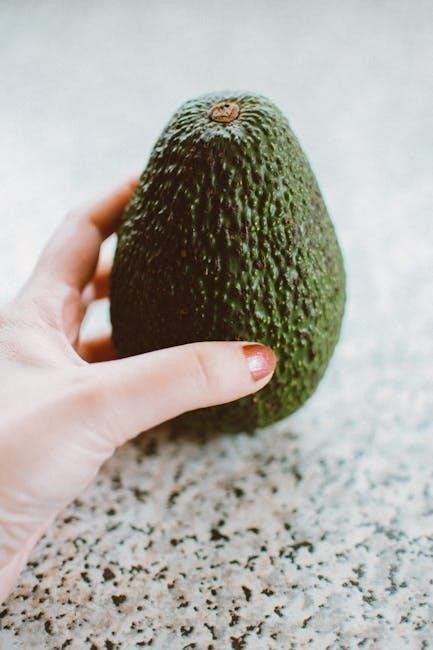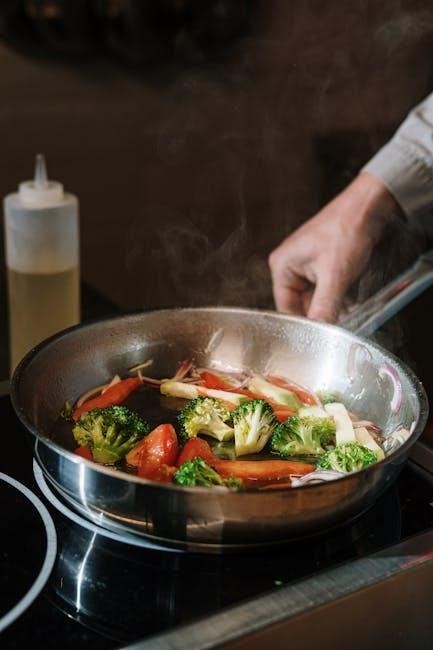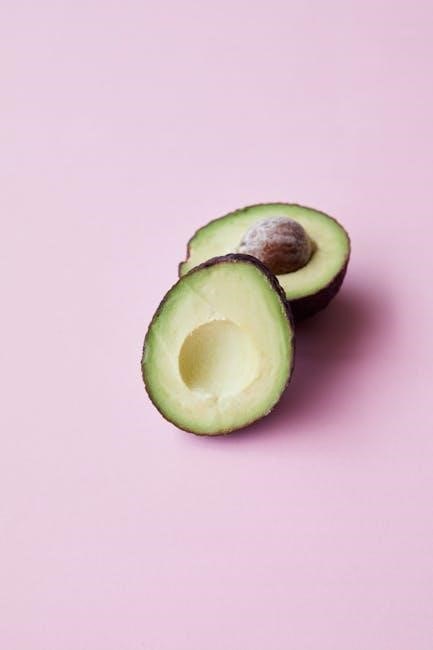A well-structured 7-day vegetarian keto meal plan offers a balanced approach to weight loss and improved health, focusing on high-fat, low-carb, plant-based meals. Perfect for those seeking a meat-free ketogenic lifestyle, this plan provides delicious and nutritious recipes, ensuring adequate protein and fiber intake while maintaining ketosis. Ideal for beginners, it simplifies meal prep and grocery shopping, making the transition to a keto diet effortless and sustainable.
Overview of the Vegetarian Keto Diet
The vegetarian keto diet combines the principles of a ketogenic diet with plant-based eating, focusing on high-fat, low-carb meals without meat. It emphasizes whole, nutrient-dense foods like nuts, seeds, avocados, and non-starchy vegetables. This diet is designed to promote weight loss, improve energy levels, and stabilize blood sugar while adhering to vegetarian preferences. By limiting carbohydrates to 20-50 grams per day and prioritizing fat intake, the body enters ketosis, burning fat for fuel. The plan is structured to ensure adequate protein intake from plant-based sources, avoiding excessive protein that could disrupt ketosis. It’s an ideal option for those seeking a meat-free lifestyle while reaping the benefits of a ketogenic diet.

Understanding the Vegetarian Keto Diet
The vegetarian keto diet seamlessly combines plant-based eating with ketogenic principles, focusing on high-fat, low-carb meals to promote weight loss and blood sugar control while avoiding meat.
What is a Vegetarian Keto Diet?
A vegetarian keto diet combines the principles of ketogenic eating with plant-based nutrition, focusing on high-fat, low-carb meals without meat. It emphasizes whole, nutrient-dense foods like nuts, seeds, avocados, and low-carb vegetables, while avoiding grains, sugars, and starchy foods. This diet promotes ketosis, a metabolic state where the body burns fat for energy instead of carbohydrates. By eliminating meat and focusing on plant-based fats and proteins, it offers a sustainable way to lose weight, improve blood sugar control, and reduce inflammation. ideal for those who prefer a meat-free lifestyle but still want to benefit from the ketogenic approach to health and nutrition.
Benefits of a Vegetarian Keto Diet
A vegetarian keto diet offers numerous health benefits, including rapid weight loss, improved blood sugar control, and reduced inflammation. By focusing on high-fat, plant-based foods, it promotes ketosis, a metabolic state that burns fat efficiently. This diet often leads to increased energy levels and mental clarity. It also encourages the consumption of nutrient-dense vegetables, nuts, and seeds, providing essential vitamins and minerals. Additionally, a vegetarian keto diet can lower cholesterol and blood pressure, reducing the risk of heart disease. Many find it more cost-effective than traditional keto diets, as plant-based proteins are often more affordable. Overall, it’s a sustainable and effective way to improve health while adhering to a meat-free lifestyle.
Challenges of a Vegetarian Keto Diet
A vegetarian keto diet can be challenging due to limited protein sources and ensuring adequate fat intake without meat. It requires careful meal planning to avoid carb overload from plant-based foods, making it essential to track macros diligently. Additionally, finding variety in meals and snacks can be difficult, leading to potential nutrient deficiencies if not properly managed. Balancing the diet to maintain ketosis while avoiding high-carb vegetarian staples like grains and legumes is also a common hurdle. However, with the right strategies and resources, these challenges can be overcome, allowing for a successful and sustainable vegetarian keto journey.
Common Challenges and Solutions
One of the primary challenges of a vegetarian keto diet is maintaining adequate protein intake without relying on meat. To address this, incorporate plant-based protein sources like tofu, tempeh, and seitan into meals. Another hurdle is avoiding high-carb plant-based foods, such as grains and legumes, which can disrupt ketosis. Opt instead for low-carb vegetables like leafy greens, broccoli, and cauliflower. Additionally, ensuring sufficient fat intake can be tricky; include healthy fats such as avocado, nuts, seeds, and olive oil in your diet. Meal planning is crucial to overcome these challenges, as it helps in tracking macronutrients and maintaining variety. With creativity and the right strategies, a vegetarian keto diet can be both satisfying and effective for weight loss and overall health.

Sample 7-Day Vegetarian Keto Meal Plan
This 7-day vegetarian keto meal plan offers a variety of high-fat, low-carb, plant-based meals designed for weight loss and overall well-being. Includes breakfast, lunch, dinner, and snacks.
Day 1: Breakfast, Lunch, Dinner, and Snacks
- Breakfast: Chia seed pudding made with coconut milk and a few berries, offering a nutritious and filling start to the day.
- Lunch: Keto-friendly vegetable soup with non-starchy vegetables like spinach, zucchini, and cauliflower, ensuring a low-carb yet satisfying meal.
- Dinner: Caprese salad with fresh mozzarella, tomatoes, and basil, dressed with olive oil and balsamic vinegar for a flavorful and healthy dinner.
- Snacks: A handful of olives or a small portion of mozzarella balls to keep energy levels steady between meals.
This meal plan focuses on high-fat, low-carb, and moderate-protein dishes, keeping you in ketosis while providing nutrient-rich options.
Day 2: Breakfast, Lunch, Dinner, and Snacks
- Breakfast: Scrambled eggs with spinach, avocado, and a sprinkle of cheese, served on a bed of sautéed greens for a nutrient-packed start.
- Lunch: Grilled portobello mushroom burger on a low-carb bun, topped with garlic mayo, lettuce, and cheese, paired with a side of cauliflower fries.
- Dinner: Zucchini noodles (zoodles) tossed in pesto sauce with roasted walnuts for added crunch and healthy fats.
- Snacks: Celery sticks with almond butter or a small serving of macadamia nuts to maintain energy levels.
This day focuses on balancing flavors and textures while adhering to keto principles, ensuring you stay satisfied and in ketosis.
Day 3: Breakfast, Lunch, Dinner, and Snacks
- Breakfast: Chia seed pudding with coconut milk, topped with fresh berries and shredded coconut for a sweet, keto-friendly start.
- Lunch: Mixed green salad with avocado, cucumber, cherry tomatoes, and a homemade ranch dressing, sprinkled with chopped walnuts.
- Dinner: Stuffed bell peppers with cauliflower rice, mushrooms, and cheese, baked to perfection for a flavorful meal.
- Snacks: Mozzarella cheese slices or a small handful of walnuts to keep energy levels steady throughout the day.
This meal plan emphasizes variety and nutrition, ensuring you stay in ketosis while enjoying delicious, satisfying meals. Each dish is designed to provide the right balance of fats, proteins, and low-carb vegetables.
Day 4: Breakfast, Lunch, Dinner, and Snacks
- Breakfast: Scrambled eggs with spinach, avocado, and cherry tomatoes, cooked in olive oil for a creamy, protein-packed start.
- Lunch: Cauliflower crust pizza topped with tomato sauce, mozzarella cheese, mushrooms, and olives, ensuring a satisfying and flavorful meal.
- Dinner: Zucchini boats stuffed with a ricotta cheese and Parmesan mixture, baked until tender and golden for a creative low-carb dish.
- Snacks: Celery sticks with almond butter and a small handful of macadamia nuts for a quick, energy-boosting snack.
This meal plan focuses on maintaining ketosis with nutrient-dense, plant-based meals. Each dish is crafted to provide a balance of healthy fats, moderate protein, and minimal carbs, keeping you satisfied and on track with your diet goals.
Day 5: Breakfast, Lunch, Dinner, and Snacks
- Breakfast: Keto smoothie made with full-fat coconut milk, spinach, almond butter, and a scoop of plant-based protein powder for a nutrient-rich start.
- Lunch: Grilled portobello mushroom burgers with zucchini slices and a side of cauliflower mash, drizzled with olive oil and garlic for flavor.
- Dinner: Stuffed bell peppers with a filling of quinoa, roasted vegetables, and vegan cheese, baked to perfection for a hearty meal.
- Snacks: A small serving of macadamia nuts and a slice of low-carb, dairy-free cheesecake for a sweet treat.
This day focuses on incorporating a variety of textures and flavors while maintaining a balance of healthy fats, moderate protein, and minimal carbs. Each meal is designed to keep you in ketosis and satisfied throughout the day.
Day 6: Breakfast, Lunch, Dinner, and Snacks
- Breakfast: Avocado toast on low-carb, grain-free bread, topped with a poached egg and a sprinkle of spinach for added nutrients.
- Lunch: A hearty salad of mixed greens, grilled tofu, cucumber, cherry tomatoes, and avocado, dressed with olive oil and lemon juice.
- Dinner: Zucchini boats stuffed with a mixture of ricotta cheese, roasted mushrooms, and bell peppers, baked until tender.
- Snacks: A small portion of mozzarella cheese sticks and a handful of fresh berries for a sweet and satisfying treat;
This day emphasizes variety and balance, ensuring you stay in ketosis while enjoying flavorful and nutritious meals. Each dish is carefully crafted to provide the right mix of fats, proteins, and low-carb vegetables to keep you energized and focused throughout the day.
Day 7: Breakfast, Lunch, Dinner, and Snacks
- Breakfast: Keto-friendly smoothie with avocado, spinach, almond milk, and a scoop of plant-based protein powder, topped with chia seeds.
- Lunch: Cauliflower pizza crust topped with marinara sauce, roasted vegetables, and dairy-free mozzarella cheese, baked to perfection.
- Dinner: Stuffed bell peppers with a filling of quinoa, black beans, diced tomatoes, and spices, baked until tender.
- Snacks: A small bowl of macadamia nuts and a few slices of cucumber with hummus for a refreshing treat.
Day 7 focuses on wrapping up the week with nutrient-dense, flavorful meals that keep you satisfied and in ketosis. The emphasis is on variety and ensuring you end the week feeling energized and motivated to continue your keto journey.

Vegetarian Keto Snacks and Desserts
Enjoy guilt-free, low-carb snacks like nuts, seeds, avocado, and keto-friendly desserts such as chia pudding, coconut macaroons, or sugar-free dark chocolate. Perfect for satisfying cravings while staying in ketosis.
Low-Carb Snack Ideas
For a vegetarian keto diet, low-carb snacks are essential to maintain ketosis. Nuts like almonds, walnuts, and pecans are great options due to their high fat content and minimal carbs. Seeds such as chia, flax, and pumpkin are also excellent choices, providing healthy fats and fiber. Avocado slices or guacamole make for satisfying snacks, while hard-boiled eggs or cheese sticks are convenient. Veggie sticks like cucumber, zucchini, and bell peppers with a keto-friendly dip are perfect for crunchy cravings. Olives, macadamia nuts, and coconut flakes are additional options. These snacks are not only delicious but also keep you in ketosis while supporting your dietary goals. Always opt for portion-controlled servings to avoid overconsumption of calories or carbs.
Keto-Friendly Dessert Recipes
Keto-friendly desserts offer a sweet escape while staying within low-carb limits. Indulge in avocado chocolate mousse, a creamy blend of avocados, cocoa powder, and sugar substitutes like stevia. Another option is keto cheesecake, made with a nut-based crust and a filling of cream cheese, eggs, and sweeteners. Coconut macaroons, chewy and rich, are a perfect treat. For chocolate lovers, sugar-free dark chocolate (over 85% cocoa) is a guilt-free indulgence. Berry-based desserts, such as strawberry chia pudding or raspberry fat bombs, are also delicious. These recipes ensure you satisfy your sweet tooth without compromising ketosis, making them ideal for a vegetarian keto lifestyle. Perfect for those seeking indulgence without the carbs, these desserts are both nourishing and delightful.
Grocery Shopping List for a Vegetarian Keto Diet
- Fats: Avocados, olive oil, coconut oil, nuts (almonds, walnuts), seeds (chia, flax)
- Proteins: Eggs, full-fat Greek yogurt, tofu, tempeh, protein powders (pea, hemp)
- Vegetables: Leafy greens (spinach, kale), broccoli, cauliflower, zucchini, asparagus
- Snacks: Cheese (mozzarella, cheddar, feta), low-carb nuts and seeds
- Condiments: Mayonnaise, mustard, sugar-free ketchup, sugar substitutes (stevia, erythritol)
- Beverages: Water, herbal teas, low-carb almond milk, coconut water
- Miscellaneous: Almond flour, healthy oils (avocado, grapeseed)
This list ensures a balanced intake of fats, proteins, and low-carb vegetables, supporting a vegetarian keto lifestyle.
Essential Items to Include
Your grocery list should focus on high-fat, low-carb, and protein-rich foods. Include avocado, nuts (almonds, walnuts), seeds (chia, flax), olive oil, and coconut oil for healthy fats. Protein sources like eggs, tofu, tempeh, and full-fat Greek yogurt are crucial. Stock up on non-starchy vegetables such as spinach, kale, broccoli, cauliflower, and zucchini. Low-carb snacks like cheese and keto-friendly nuts are great for quick bites. Condiments like mayonnaise, mustard, and sugar-free ketchup add flavor. Beverages should include water, herbal teas, and low-carb almond milk. Miscellaneous items like almond flour and healthy oils complete your pantry. This selection ensures a balanced and satisfying vegetarian keto diet, making meal prep easy and enjoyable. Proper planning prevents cravings and supports ketosis, helping you stay on track with your health goals.
Tips for Staying on Track with a Vegetarian Keto Diet
Plan meals in advance, track macros, and stay hydrated. Incorporate variety to avoid boredom and ensure nutrient balance. Focus on whole foods and mindful eating to maintain ketosis and consistency.
Meal Prepping and Planning
Meal prepping is essential for adhering to a 7-day vegetarian keto meal plan. Start by planning your meals for the week, ensuring each day includes high-fat, low-carb options. Create a grocery list based on your plan to avoid last-minute purchases. Prep ingredients like chopped vegetables, marinated tofu, or cauliflower rice in advance. Cook meals in bulk, such as soups or casseroles, and portion them for easy grab-and-go options. Use a macro tracker to monitor your intake of fats, proteins, and carbs. Stay hydrated and incorporate healthy snacks to maintain energy levels. Flexibility is key—swap out ingredients or recipes as needed to keep meals exciting. Meal prepping not only saves time but also helps maintain consistency and avoids temptation. It’s a practical way to stay committed to your ketogenic journey while enjoying delicious, nutrient-rich meals.

Frequently Asked Questions
What are the best protein sources on a vegetarian keto diet?
Eggs, tofu, tempeh, and cheese are excellent protein sources that fit within a ketogenic diet;
Can I eat dairy on a vegetarian keto diet?
Yes, dairy products like cheese, butter, and full-fat yogurt are allowed, as they are low in carbs and high in fat.
How do I ensure I get enough fiber?
Incorporate low-carb vegetables, nuts, seeds, and avocado to meet your daily fiber needs while staying in ketosis.
What snacks are keto-friendly and vegetarian?
Opt for nuts, seeds, cheese, and low-carb vegetables like cucumbers and bell peppers.
Can I follow this diet if I’m a vegan?
Yes, but you’ll need to focus on plant-based fats like avocados, nuts, and seeds, and ensure you meet your protein requirements with tofu and legumes.
Common Questions About the Vegetarian Keto Diet
What are the best protein sources for vegetarians on a keto diet? Eggs, tofu, tempeh, and legumes are excellent options.
Can I eat dairy products? Yes, dairy like cheese, butter, and full-fat yogurt is allowed and fits within keto guidelines.
How do I stay hydrated? Drinking plenty of water and incorporating electrolyte-rich foods like avocado and spinach is crucial.
Can I eat nuts and seeds? Absolutely, as they are great sources of healthy fats and fiber.
What about fiber intake? Focus on low-carb vegetables, nuts, and seeds to meet your daily fiber needs.
Are there vegan-friendly options? Yes, but ensure you consume enough plant-based fats and protein from sources like avocados and tofu.
How do I track macros? Use a macro calculator or tracking app to monitor your daily carb, protein, and fat intake.
Is the diet sustainable long-term? With proper planning, it can be a sustainable and healthy lifestyle choice.
Remember, consistency and meal prep are key to success on a vegetarian keto diet!



